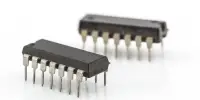Organic electronics is a material science subject that focuses on the design, synthesis, characterization, and use of organic molecules or polymers with desirable electrical properties such as conductivity. It is an area of materials science and electronics that focuses on the research and implementation of organic compounds (carbon-based materials) for electrical devices. It is also known as organic or polymer electronics.
Organic electronic materials, as opposed to typical inorganic conductors and semiconductors, are made from organic (carbon-based) molecules or polymers utilizing synthetic techniques discovered in the context of organic chemistry and polymer chemistry. These organic compounds have the ability to conduct electricity, emit light, and have other electronic features.
Organic electronics’ projected cheap cost in comparison to standard electronics is one of the stated benefits. Polymeric conductors are appealing due to their electrical conductivity (which may be adjusted by dopant concentrations) and relatively high mechanical flexibility. Organic electronic materials face implementation challenges due to their poor thermal stability, high cost, and a variety of manufacturing problems.
Key aspects and components of organic electronics include:
- Organic Semiconductors: Organic electronics is built on these semiconductors. Organic materials can conduct electricity, but not as efficiently as standard inorganic semiconductors. They’re commonly found in transistors, diodes, and other electronic components.
- Organic Thin-Film Transistors (OTFTs): Organic thin-film transistors are critical components in organic electronics. They are utilized in integrated circuits and displays as switching elements. When compared to silicon-based rivals, OTFTs offer the benefit of being more flexible, lighter, and potentially less expensive to manufacture.
- Organic Light-Emitting Diodes (OLEDs): OLEDs are a popular application of organic electronics. They are used in displays, TVs, smartphones, and lighting. OLEDs emit light when an electric current is applied and are known for their vibrant colors, thin form factor, and energy efficiency.
- Organic Photovoltaics (OPVs): Organic photovoltaics, also known as organic solar cells, use organic materials to convert sunlight into electricity. While they are not as efficient as traditional silicon-based solar cells, OPVs have the advantage of being lightweight, flexible, and potentially less expensive to produce.
- Organic Sensors: Organic materials can also be used to create various types of sensors, such as chemical sensors and biosensors. These sensors are used in applications like environmental monitoring and healthcare.
- Flexible and Printed Electronics: Organic electronics is inextricably linked to flexible and printable electronics. These technologies allow for the creation of electronic devices on flexible substrates and via printing methods, which can result in novel form factors and cost-effective manufacturing.
Organic electronics have several advantages, including their flexibility, lightweight nature, and the potential for low-cost, large-area fabrication. However, there are still hurdles in enhancing the efficiency and stability of organic electrical systems in comparison to their inorganic counterparts. Researchers are still working on generating novel organic materials, enhancing gadget performance, and tackling environmental stability challenges.
















